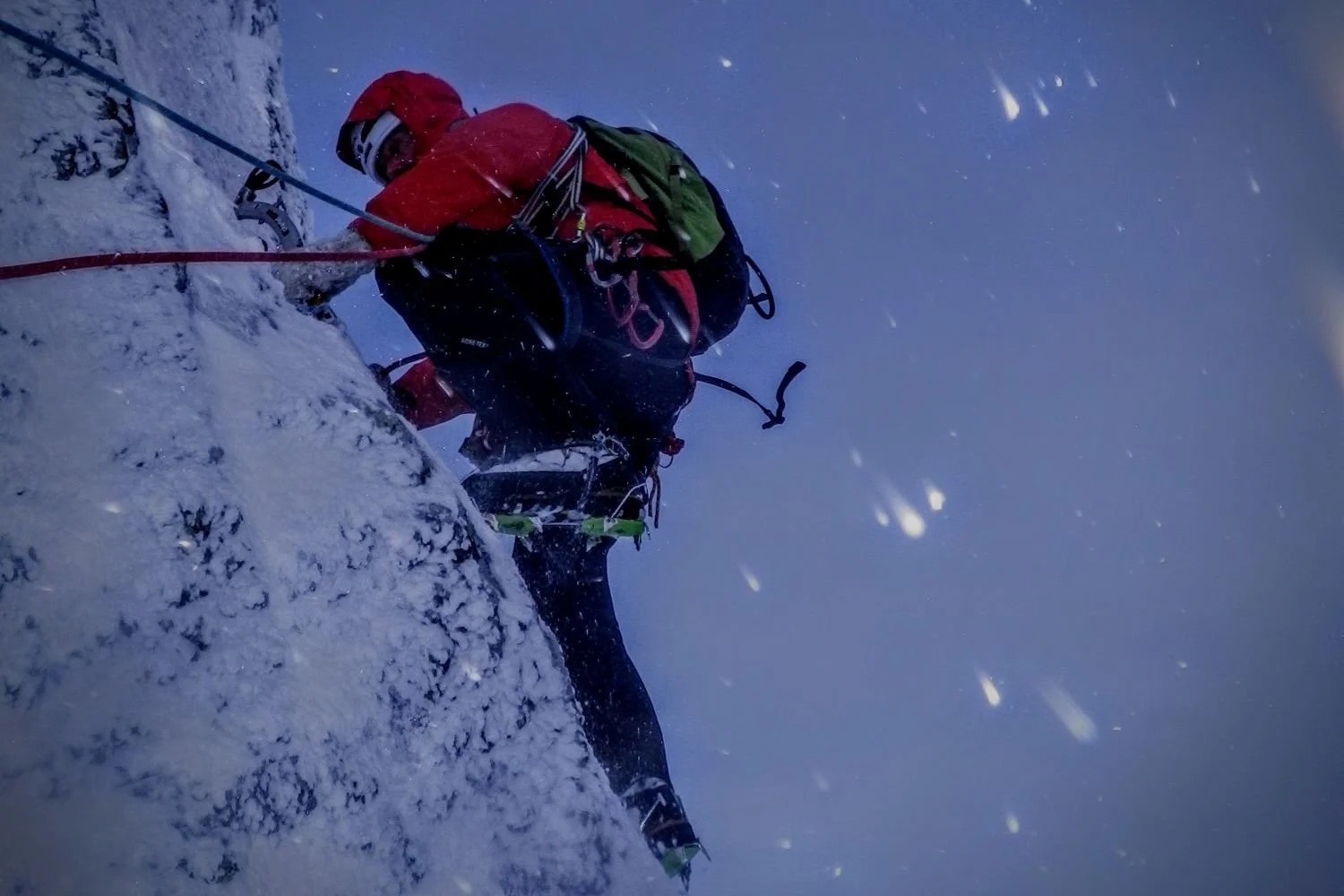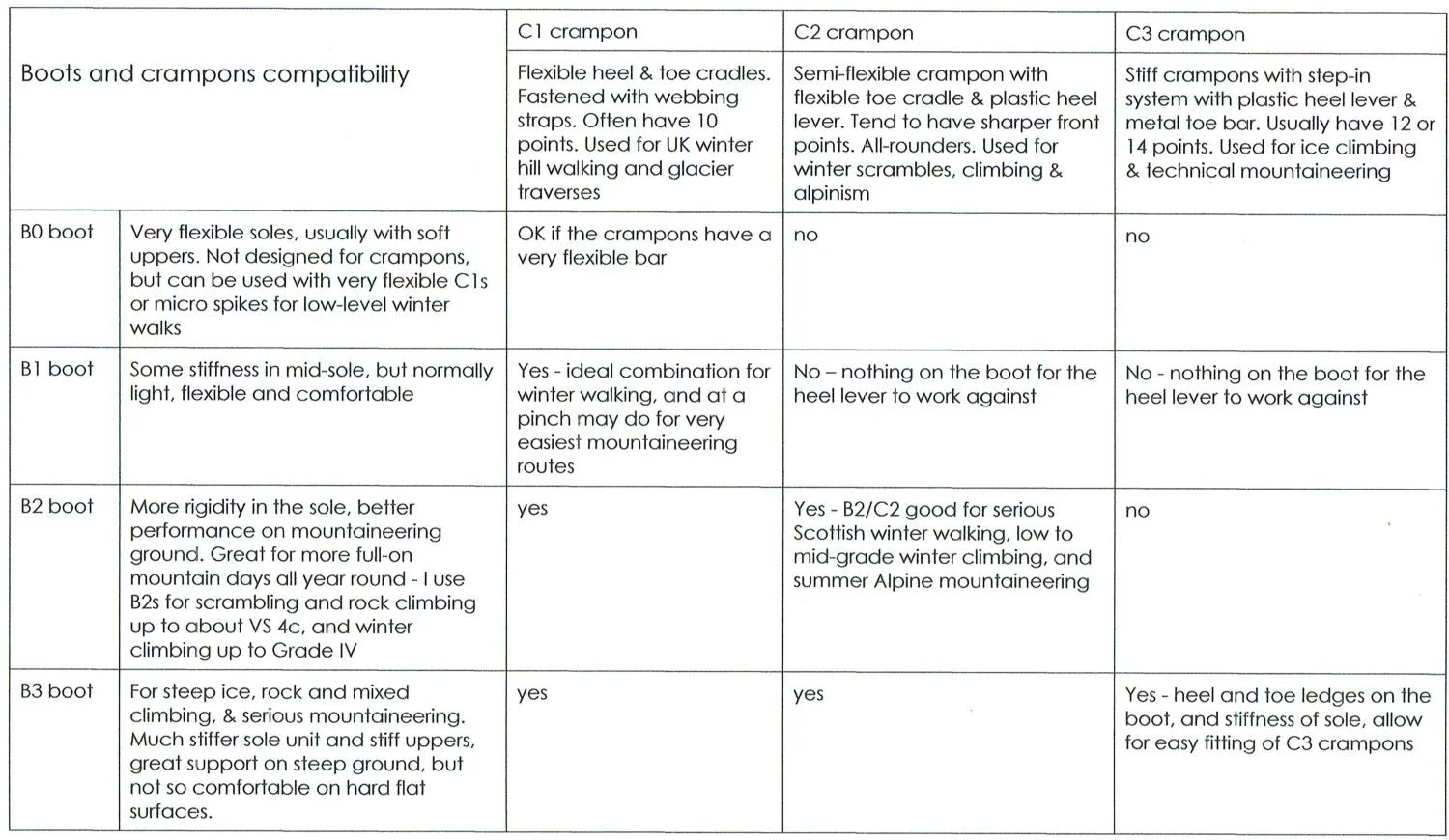Everything You Need To Know About Crampons
/WRITTEN by CHRIS & ANNE ENSOLL
When you’re heading out into the mountains in the winter, it’s really important that you’re properly kitted out on your feet, with suitable boots and the right crampons to go with them. We often get asked the question, What kind of boots do I need? B1, B2 or B3? And what kind of crampons do I need, C1, C2 or C3? The answer is, it depends!
Balck Diamond Stinger C3 crampons used for winter climbing
So what does it depend on? You really need to consider two questions when choosing your crampons:
Will the binding be compatible with my boots?
Will the crampons and boots be compatible with my mountaineering aspirations?
Crampons are toothed metal devices, that fit to the soles of mountaineering boots to give more grip on snow and ice. There are various types and designs and what you choose will depend on the type of boot you are wearing and what you are using the crampons for. Your crampons need to be compatible with your boots so that they can work correctly.
Crampons are made up of two distinct sections:
The base, which can be hinged or rigid, is made up of the points, the attachment/flex bar and the anti-balling plates
The strapping system, which attaches them to the boots, is made up of the front cage or bail, the heel clip and the straps
All crampons are given a C-rating, which determines their use. The C-rating depends mostly on the binding - or the way it attaches to the boot - rather than the base, because it is an indication of what kind of boot a crampon binding will fit, regardless of the crampon's point configuration.
Petzl Vasak Leverlock Universel C2 crampon
Crampon Points
The points are placed at the contact areas beneath the forefoot and heel. Most crampon points are made from steel or stainless steel, but some lightweight styles, for example for ski touring, are made from aluminium.
The number of points affects the use of the crampon. Crampons designed for gentle gradients such as glacier walking and ski touring will usually have ten points. Those designed for more technical mountaineering will have twelve points and those designed for technical ice climbing will often have fourteen. Almost all designs will have four points beneath the heel and the rest beneath the forefoot.
The front points can be either horizontal or vertical. Horizontal points give excellent purchase on snow and softer ice, making them a great choice for winter walking and moderate ice routes but not for technical ice climbing. Vertical front points work like an ice axe, driving straight into the ice and giving a secure hold on mixed and steep ice routes. They need more precision and give less stability on flatter sections, making them less suited for gentler winter walking routes.
Hybrid points are a cross between the two - a vertical point with a horizontal profile at the top, giving the stability on snow of horizontal points and the bite of vertical points when routes become more demanding.
Dual point crampons have two front points, and they are the most popular option for those looking to use a crampon for everything short of technical ice climbing. Monopoint crampons have a central point at the front, giving the precision needed on technical climbs. Some technical crampons have a modular point system, allowing you to change between a dual and monopoint system easily.
Taken on our Intor Winter Mountaineering course in January 2022
Flex Bar
The flex bar joins the front and rear plates. The bar and the way it attaches to the plates dictates the flex of the binding. Articulated crampons have more play for softer boots, while C3 crampons will be almost fully rigid. Bars are easily adjusted according to the size of the boot.
Anti-Balling Plates
Anti-balling or 'antibot' plates reduce the build up of snow in the base of the crampon, which prevents the points from biting into the snow. They are made from a rubbery plastic material, and they clip into the base and over the bar.
Binding Systems
Crampons fix to your boots using three different systems, and these affect their C-rating:
Strap-on crampons (C1) utilise a toe basket/cage and a binding strap to wrap and secure the boot.
Hybrid crampons (C2) have a toe basket/cage and heel clip for a very secure fit and a strap.
Step-in crampons (C3) have both a toe clip or bail and heel clip, and they give the closest fit.
Often a particular type of base is available with a variety of different binding systems. For instance, Petzl Vasak crampons have a choice of the Flexlock binding (C1), or the Leverlock Universel binding which can be used in either a C2 or C3 mode.
Download a PDF of the chart here
My recommendations
These are my current favourite boots/crampons combinations. I have standard width, standard shaped feet.
B1/C1
Scarpa R-Evo GTX boots with Petzl Irvis crampons with Flexlock binding - I don’t own these crampons but they will be the next pair I buy.
B2/C2
Scarpa Ribelle Lite HD boots with Petzl Vasak crampons with Leverlock Universel (C2) binding
B3/C3
Scarpa Phantom Tech HD boots with Petzl Dart or Petzl Lynx crampons. I don’t have either of these crampons because when I bought my last C3 pair, these models didn’t have anti balling plates. They do now, and I have friends have them and rate them, so I would definitely buy them now.
Caring for crampons
Invest in a crampon bag to store them, and when in transit to protect your other gear - the points will easily snag fabric or rope. Make sure your crampons are dry when you put them away to avoid rust forming on any exposed steel. As an extra precaution, a light coat of oil for long term storage will increase protection.
C2 crampons used for winter scrambling
Want to learn more?
Find out about our winter mountaineering and climbing courses in Scotland and the Lake District, and our one-day Winter Mountaineering Masterclass and Winter Scrambling Masterclass.








